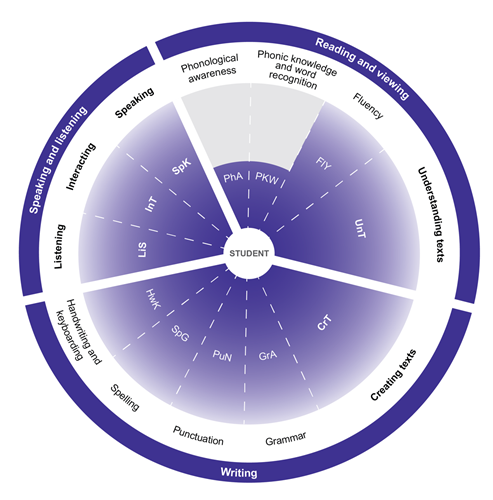Every teacher can play a role in developing and implementing teaching strategies that are inclusive of Koorie students cultural and linguistic diversity from
DET Multimedia on
Vimeo.
The first dialect is a foundation to learning, so incorporating Koorie English in the classroom is crucial for positive learning outcomes. English as an Additional Language teaching strategies can be used to support Koorie English speakers with mastering Standard Australian English. Students can be empowered through knowing when to use Koorie English and/or SAE to achieve improved academic outcomes.
Assessing the literacy demands of a subject
The graphic below outlines the elements and sub-elements of the National Literacy Learning Progressions from
ACARA. This figure can be used to help identify the literacy demands of any subject or course.
 Elements and sub-elements of the National Literacy Learning Progression
Elements and sub-elements of the National Literacy Learning Progression
The following questions can help identify opportunities to utilise Koorie English and/or explicitly teach Standard Australian English.
- What are the literacy demands of this lesson/course? (Creating texts? Interacting? Understanding texts?)
- What knowledge or skill are students expected to acquire in this lesson?
- What knowledge or skills are students expected to have before this lesson?
- How will students demonstrate this knowledge or skill?
- What level of SAE is required to demonstrate this knowledge or skill?
- What aspects of SAE do students need to know to complete the task?
- How have I explicitly taught or modelled these aspects of SAE?
Key considerations for Koorie English speaker literacy needs
| Reading and viewing | Speaking and listening | Writing |
|---|
- Cultural understandings of words, symbols, values etc.
- Explicitly outline the process for decoding and interpreting texts.
- Overload of metalanguage and academic jargon.
- Phonic knowledge and word recognition.
- Connection to context.
| - Non-verbal communication (silence, eye-contact etc).
- Different pronunciations or mishearing words and sounds.
- Different grammatical and syntax structures.
- Not recognising turn-taking protocols.
- Possibility of ‘shame’ (standing out).
| - Being brief and to the point.
- Possibility of ‘shame’ (standing out).
- Different grammatical and syntax structures.
- Spelling and pronunciation of words.
- ‘Aboriginal Storytelling’.
|
Classroom practice advice
- Although the focus is on Koorie English speakers, the strategies and content presented will assist other students with diverse needs.
- The home language or dialect should be embraced in the classroom as the basis for meaning-making and literacy development.
- Standard Australian English is the language of assessment in schools.
- Teachers must evaluate and explicitly teach the language demands and skills required to complete the assessment.
- Accept, and do not correct, answers from students in Koorie English.
- The acceptance of Koorie English in the classroom will not be effective unless Koorie culture is embraced within the curriculum and wider school culture.
- Allow opportunities for students to engage in Koorie perspectives across the curriculum.
Additional reading
 Sharing knowledge, building understandings - April Edwards (pdf - 1.1mb)
Sharing knowledge, building understandings - April Edwards (pdf - 1.1mb)
 Sharing knowledge, building understandings - April Edwards (docx - 289.91kb)
Sharing knowledge, building understandings - April Edwards (docx - 289.91kb)